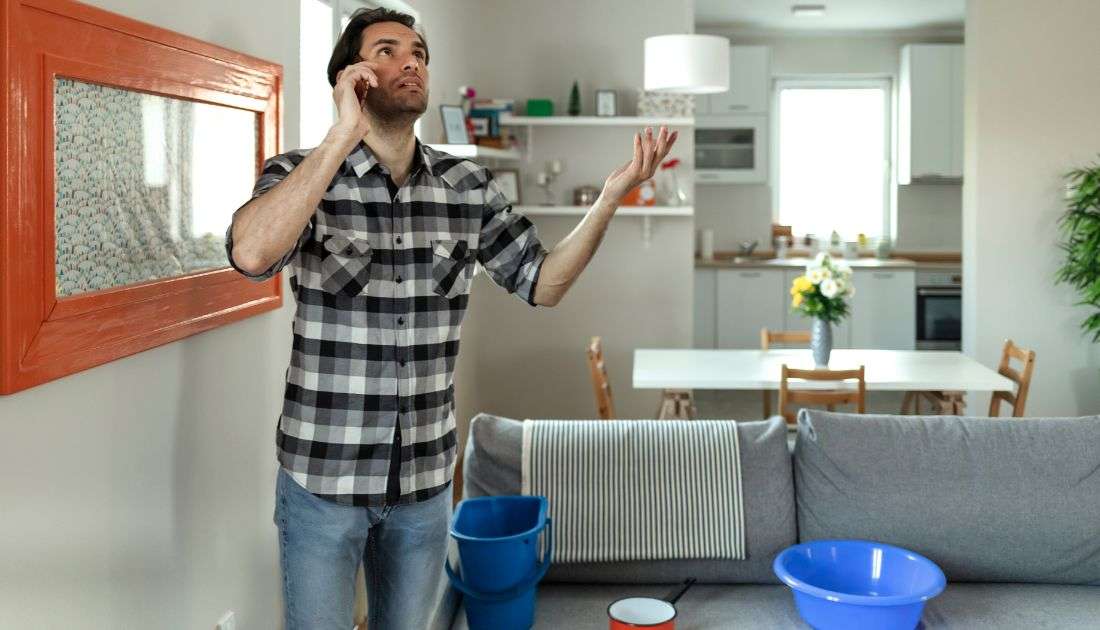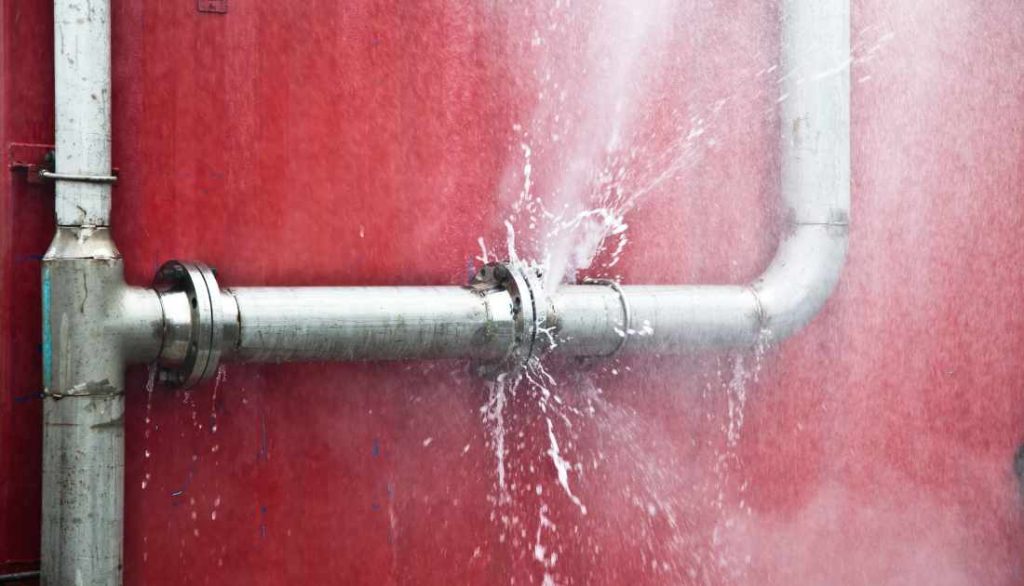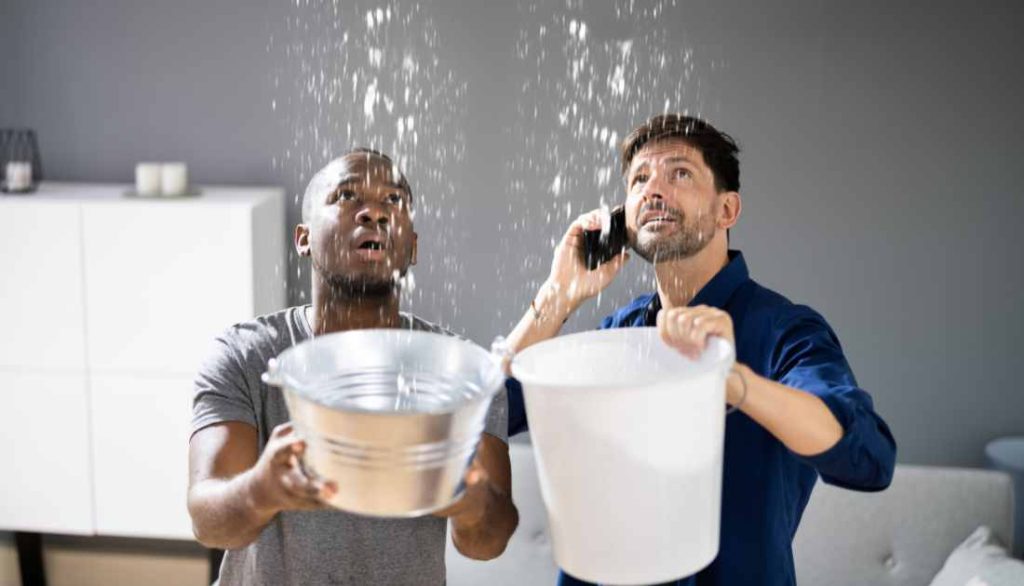Table of Contents
Have you ever heard the sound of water running but couldn’t find where it came from? It may sound like a faint trickling noise or more like rushing wind. But on the other hand, it could indicate a serious plumbing issue somewhere in your home. It can be an alarming thought. Spotting and fixing these leaks as soon as possible is important. It is to avoid thousands of square feet of costly water damage.
In this article, we’ll explain what causes water leak noises. And how to identify them. We even provide tips on finding the source of a lurking problem before it becomes a disaster.
Water Leak Classification: Catastrophic vs. Costly
Water leaks can be categorized into two main categories: catastrophic and costly.
Catastrophic leaks result in severe and extensive damage to property and infrastructure and even pose risks to human health and safety. These leaks often occur suddenly and without warning. If not addressed promptly, they can cause significant flooding, structural damage, and potential mold growth. Examples of catastrophic water leaks include burst pipes, roof leaks during heavy rainstorms, and failures in hot water tanks.
Costly water leaks encompass various scenarios that result in significant financial burdens:
- Burst Pipes: Rapid water damage to structures necessitates costly repairs and restoration.
- Roof Leaks: Unnoticed leaks lead to extensive damage, including mold growth and structural issues.
- Leaking Fixtures: Persistent leaks from faucets or toilets inflate water bills and damage surrounding areas.
- Appliance Failures: Malfunctioning appliances cause water damage and require expensive repairs or replacements.
- Leaking Underground Drains: Detecting and repairing underground leaks incur substantial excavation and labor costs.
- Hot Water Tank Failures: Leaks from hot water tanks damage surrounding areas and require tank replacement.
These costly water leaks diminish property value and impose significant financial burdens, underscoring the importance of proactive maintenance and detection measures.
What Constitutes Catastrophic Water Leaks?
What constitutes catastrophic water leaks is their potential to cause widespread destruction and disruption. Burst pipes, for instance, can lead to flooding within minutes, damaging floors, walls, and valuable belongings.
Roof leaks, especially during severe weather conditions, can compromise buildings’ structural integrity, leading to costly repairs and safety hazards.
Hot water tank failures can cause extensive water damage and scalding injuries. Identifying and addressing catastrophic water leaks promptly is crucial to minimizing costs and risks.
Roof Leaks
Roof leaks can result from various factors, including damaged or missing shingles, deteriorated flashing, clogged gutters, or poorly installed roofing materials. These issues can allow water to penetrate the roof, leading to leaks.
Signs of a roof leak may include water stains on ceilings or walls, damp or musty odors, and visible water dripping or pooling indoors during rainfall. Besides causing property damage, roof leaks can pose health and safety risks. Mold and mildew growth in damp areas can exacerbate respiratory issues and allergies.
Additionally, water leakage can compromise the structural integrity of the building, potentially leading to collapse in severe cases. Prompt identification and repair of roof leaks are essential to mitigate these risks and prevent further damage to the property.
Burst Pipes
Burst pipes can occur for various reasons, such as freezing temperatures, corrosion, high water pressure, or physical damage. A pipe burst can release significant water into the surrounding area, causing immediate harm to property and belongings.
Signs of a burst pipe may include water gushing or flowing uncontrollably, damp spots on walls or floors, and a sudden decrease in water pressure. Burst pipes pose both health and safety risks to occupants and the property.
Water damage can promote mold and bacteria growth, leading to respiratory issues and other health problems.
Additionally, standing water can create slip and fall hazards, electrical hazards, and structural damage if not addressed promptly. Proper insulation, regular maintenance, and timely repairs prevent burst pipes and minimize associated risks.
Leaking Fixtures
Leaking fixtures such as faucets, showerheads, or toilets can result from worn-out seals, loose connections, or faulty components. Even small leaks can waste a significant amount of water and lead to water damage over time.
Common signs of leaking fixtures include dripping or running water, water stains or discoloration, and a musty odor. While leaking fixtures may seem minor, they can have serious health and safety implications.
Persistent moisture can create an ideal mold and mildew growth environment, which can exacerbate allergies and respiratory issues. Additionally, water leakage can damage surrounding structures, leading to costly repairs and potential safety hazards.
Regular inspection and maintenance of fixtures and prompt repairs when leaks are detected are essential in preventing water damage and maintaining a safe and healthy living environment.
Leaking Underground Drains
Leaking underground drains can occur due to corrosion, tree root intrusion, ground movement, or poor installation. Signs of leaking underground drains may include water pooling in the yard, sinkholes or depressions in the ground, foul odors, or unusually lush vegetation in certain areas.
While underground leaks may not always be immediately visible, they can have significant health and safety implications. Standing water can attract pests like mosquitoes and rodents, increasing the risk of vector-borne diseases.
Additionally, leaking drains can undermine the stability of the soil, leading to sinkholes or foundation issues. Contaminants from underground leaks can also seep into groundwater sources, posing risks to public health.
Prompt detection and repair of leaking underground drains are essential to prevent environmental contamination, property damage, and associated health hazards. Regular inspection and maintenance can help identify leaks early and mitigate their impact.
Toilet Supply Line Failures
Toilet supply line failures can stem from various causes, including deterioration due to age, corrosion, high water pressure, or faulty installation. Over time, wear and tear weaken the supply line, leading to leaks or complete ruptures. Poor maintenance and inadequate inspection exacerbate the risk of failure.
Signs of a toilet supply line failure often manifest as water leakage around the toilet base or pooling water near the supply line connection. Additionally, decreased water pressure in the toilet tank or visible corrosion on the supply line can indicate a potential problem.
Health and safety implications of toilet supply line failures include water damage to floors, walls, and ceilings, promoting mold growth and compromising structural integrity. Furthermore, untreated leaks can escalate water bills and contribute to environmental waste. In severe cases, flooding from a supply line failure can pose slip and fall hazards, electrical risks, and contamination of water sources, necessitating immediate remediation measures.
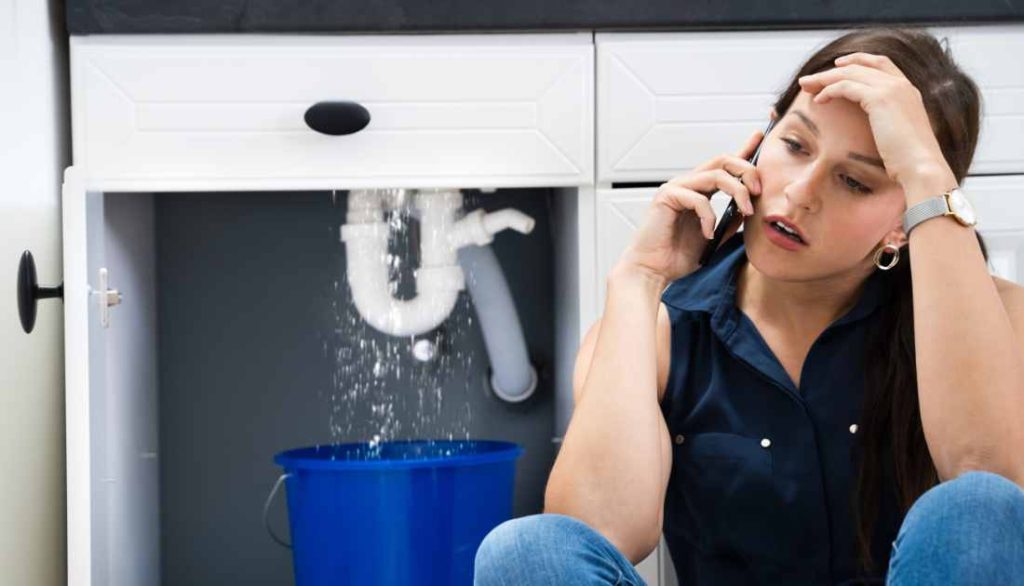
Appliance Failures
Appliance failures can result from various factors, including mechanical malfunctions, electrical issues, wear and tear, and improper maintenance. Faulty components, such as motors, heating elements, or control panels, may degrade over time, leading to appliance breakdowns.
Signs of impending appliance failures often include unusual noises, abnormal vibrations, erratic behavior, or inability to operate as expected. For example, a refrigerator may struggle to maintain proper temperature, a dishwasher might leave dishes dirty, or a washing machine could leak water during operation.
The health and safety implications of appliance failures can vary depending on the appliance type and the severity of the malfunction. Electrical appliances risk fire or electric shock if faulty wiring or components are involved.
Additionally, malfunctioning appliances can disrupt daily routines, leading to inconvenience, stress, and potential financial costs associated with repair or replacement.
Hot Water Tank Failures
Hot water tank failures can be caused by corrosion, sediment buildup, excessive pressure, or manufacturing defects. Over time, the tank’s metal components may degrade due to exposure to hot water and minerals in the supply.
Signs of hot water tank failures typically include leaks around the tank, rusty or discolored water, inconsistent water temperature, or unusual noises during operation. In severe cases, a burst tank can result in significant water damage to surrounding areas and belongings.
Health and safety implications of hot water tank failures include the risk of scalding injuries from sudden bursts of hot water and potential property damage from flooding.
Additionally, prolonged exposure to moisture and mold growth resulting from a leaking tank can pose respiratory health risks for occupants. Prompt detection and repair of hot water tank issues are essential to mitigate these hazards and ensure the continued safe operation of the water heating system.
Detecting Hidden Water Leaks in Your Home
Detecting Hidden Water Leaks in Your Home can save you from potential damage and costly repairs.
One effective method is the Water Meter Test, where you turn off all water sources and monitor the meter for any movement indicating a leak.
Similarly, the Water Pressure Test involves shutting off all water outlets and checking for pressure drops, which could signal a leak.
Listening to Running Water is another simple yet effective technique, especially in quiet environments, where the sound of running water can lead you to hidden leaks.
Inspecting Appliances for Leaks is crucial, as malfunctioning appliances can be sources of water leaks.
Checking Toilets for Leaks is essential, as toilet leaks can often go unnoticed but contribute significantly to water wastage and damage.
Monitoring Utility Bills might seem indirect, but sudden spikes in water usage can indicate a hidden leak.
Lastly, observing Water Drips and Wet Walls can uncover leaks concealed within walls or ceilings.
Regular vigilance and employing these detection methods can help catch water leaks early, preventing extensive damage to your home and saving you money on repairs and water bills.
Addressing Common Water Leak Issues:
Water leaks can cause significant damage to your home if not promptly addressed. Fortunately, basic troubleshooting and repair techniques can fix many common water leak issues.
Repairing a Dripping Tap:
A dripping tap is annoying and can save a significant amount of water if left unattended. Fortunately, repairing a dripping tap is a relatively straightforward task that can be completed with a few basic tools and materials.
The first step is to turn off the tap’s water supply by shutting off the main water valve or using isolation valves under the sink. Once the water supply is turned off, disassemble the tap by removing the handle and cover to access the internal components.
Inspect the washers, O-rings, and other seals for signs of wear or damage, as these are common culprits for dripping taps. Replace worn-out components with new ones of the same size and type, ensuring a proper fit.
Reassemble the tap carefully, taking care not to overtighten any fittings, which could cause damage. Turn the water supply back on and test the tap for leaks. If the dripping persists, double-check the tightness of the fittings and consider seeking professional assistance if needed.
By addressing a dripping tap promptly, you can prevent water waste, lower your water bills, and avoid potential water damage to your home. Repairing a dripping tap with a little DIY know-how and the right tools can be a simple and rewarding task.
Fixing a Leaking Plastic Water Pipe:
Fixing a leaking plastic water pipe requires a systematic approach to identify and address the source of the leak.
Begin by shutting off the water supply to the affected area to prevent further leakage and potential water damage.
Next, carefully inspect the pipe to locate the source of the leak.
Common causes may include cracks, holes, or loose fittings.
Once the leak has been identified, clean the area surrounding the leak to ensure proper adhesion of any repair materials.
Depending on the severity of the leak, options for repair may include using epoxy putty, pipe repair tape, or pipe clamps.
Apply the chosen repair method according to the manufacturer’s instructions, ensuring a secure and watertight seal.
Finally, turn the water supply back on and monitor the repaired area for any signs of continued leakage.
Rectifying a Leaking Plastic Water Pipe Joint:
When faced with a leaking plastic water pipe joint, prompt action is essential to prevent water damage and potential mold growth.
To minimize further leakage, begin by turning off the water supply to the affected area. Next, carefully inspect the joint to identify the source of the leak.
Common issues may include worn-out seals, loose fittings, or improper installation. Once the source of the leak has been identified, clean the joint and surrounding area to remove any dirt or debris that may compromise the repair.
Depending on the severity of the leak, rectification options may include replacing the faulty seal, tightening the fittings, or applying a plumber’s tape.
Ensure that any repair materials are applied correctly to create a secure and watertight seal.
Finally, turn the water supply back on and monitor the joint for any signs of continued leakage.
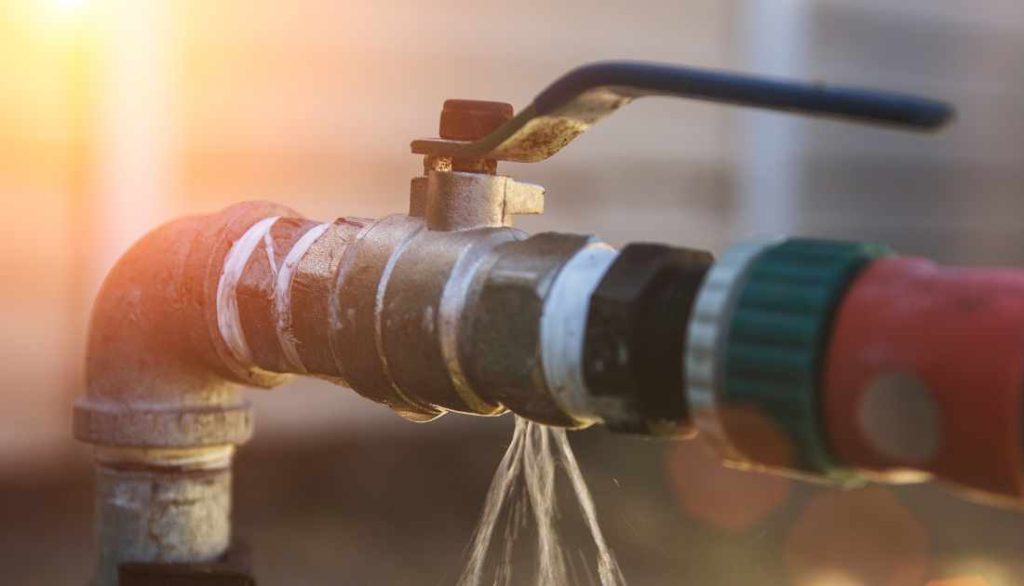
Repairing a Leaking Shower Head:
A leaking shower head can lead to water wastage and increased utility bills if addressed.
Begin by turning off the water supply to the shower to prevent further leakage.
Next, carefully inspect the shower head to identify the source of the leak.
Common causes may include worn-out washers, damaged seals, or mineral buildup.
Once the source of the leak has been identified, disassemble the shower head using a wrench or pliers, taking care not to damage the fixtures.
Clean the components thoroughly to remove any debris or mineral deposits causing the leak.
Depending on the severity of the leak, options for repair may include replacing the washers, seals, or entire shower head assembly.
Reassemble the shower head, ensuring that all components are tightly secured.
Finally, turn the water supply back on and test the shower head for any signs of continued leakage.
Addressing a Leaking Toilet Base:
If left unresolved, a leaking toilet base can lead to water damage and potential structural issues. To prevent further leakage, begin by turning off the toilet’s water supply.
Next, carefully inspect the toilet base to identify the source of the leak. Common causes may include damaged wax seals, loose bolts, or cracks in the toilet base. Once the source of the leak has been identified, remove the toilet from its base to access the underside.
Replace the wax seal with a new one, ensuring a proper fit and seal between the toilet and the floor. Tighten any loose bolts and inspect the toilet base for any cracks or damage that may need repair.
Consider applying epoxy or silicone sealant to reinforce the base if cracks are present. Reinstall the toilet and securely tighten the bolts. Finally, turn the water supply back on and monitor the toilet base for any signs of continued leakage.
Common Causes of Water Leak Noises
Common causes of water leak noises are most often plumbing-related. These issues can include the following.
- Faulty shut-off valves
- Loose pipes
- Cracked or corroded pipes
- Clogs in the sewer line
These sounds may not be loud enough to be heard. They can become more pronounced if the plumbing problem is large enough.
Another common cause of water leak noises may be a damaged water heater or pressure tank. If a water heater or pressure tank leaks, it can cause a rumbling or banging sound, particularly when the water flow increases. If the pressure tank is too full, it can also create a mumbling or whispering sound. A broken pipe or water line can also cause a hissing or whistling sound.
Identifying and repairing noisy water leaks quickly is essential. It is to prevent further water damage and costly repairs. If you suspect a water leak in your home, contact a qualified plumber to inspect the area. He will provide an appropriate solution.
What to Do if You Have a Leak Issue
If you can hear water running but can’t find the source of the leak, there are a few steps you can take to investigate the issue.
First, you should inspect any visible pipes near the sound’s location to ensure they are not dripping or leaking. This step is especially important if exposed piping is in your basement or attic. Also, inspect any external faucets, fixtures, and hoses for any signs of leaking.
Moreover, if you don’t find any visible leaks, the problem may be internal. To check this, you should turn off all the main water supply valves in your house. Then, go to each plumbing fixture and check if the water is still running. If you find a plumbing fixture still running, you have a plumbing issue and should contact a professional immediately.
Finally, if you can’t detect any visible leaks or still hear water running, you may have an issue with your main water line. In this case, you must contact a professional plumber to diagnose the leak. He can provide a solution properly.
Remember, finding the source of the leak and taking action quickly is the key to avoiding thousands of dollars in costly repairs.
What Causes Water Leak Noises?
Water leak noises occur when there is a plumbing issue in the home. Various issues, such as corroded pipes, loose connections, blocked drains, and poor water pressure, can cause it. When you hear water running but can’t find the leak, it can be difficult to figure out where it’s coming from.
The type of noise you hear can be a warning sign of the issue. For instance, a faint trickling sound could indicate a slow leak from a pipe, while a louder rushing sound could indicate a blockage in a drain.
Therefore, it’s important to identify the type of noise you hear to identify the problem. If you need clarification on what type of noise it is, contact a professional to take a look.
To best identify the source of a water leak noise, it’s important to check for water staining or dampness.
- On your home’s walls
- Ceilings or floors
Above stated areas have visible symptoms of a water leak. You can use a professional-grade pipe locator if you have located the noise source. It is used to pinpoint the exact location. An experienced plumber can also come to your home to diagnose the problem. He can determine the best course of action.
How to Identify Water Leak Noises
Water leaks can be one of the most difficult plumbing issues to detect. The leak source is often hidden behind walls and floors. It makes it nearly impossible to find without specialised tools and knowledge. Fortunately, the sound of running water is often the first indicator. It makes you think that something is amiss.
The first step in isolating the source of the leak is to listen carefully. Determine whether the noise comes from the walls, the floor, or elsewhere. Pay attention to the frequency and volume of the sound and what direction it is coming from. In some cases, the source may get located on a higher floor or in an area that is more difficult to access.
In addition to listening for the source of the leak, you should also look for signs of water damage. It might include
- Wet spots on walls or floors
- Peeling wallpaper
- Discolouration in the ceiling or walls
Pay attention to this checklist and follow them to the source. If the problem persists, you may need to call a professional plumber. He can help you identify and repair the leak.
How to Locate the Source of the Leak?
To begin, it is important to understand why you are hearing this noise in the first place. In most cases, it is because of a leak somewhere in the system. It ranges from a crack in the pipe to a loose connection or even a faulty valve. This leak can create excess pressure in the system and cause a water-like noise you can hear.
Once you have determined that there is a leak present, the next step is to locate the source of the leak. The primary method for locating the source of a leak is first to use a flashlight. It is to check all visible pipes and fittings for any signs of water.
Additionally, you can use a stud finder to locate any walls or ceilings that might have been affected. Once you have identified the potential source of the leak, you can use a moisture meter. It is used to detect the exact location and severity of the leak. If the leak is still not visible, you may need to enlist the help of a professional plumber. A qualified plumber can use tools and methods to locate and repair the leak’s source.
Additionally, they can provide more advice or tips on how to prevent future water damage. Finding the source of a water leak can be difficult. You can locate and repair the source quickly and easily with the right tools and knowledge. By taking the time to take action, you can save yourself from thousands of dollars in water damage.
Checklist to Identify a Leak
In addition to the items above, you may also refer to the following checklist to identify a leak:
- Signs of a Water Leak
- Conduct a Dye Test to Indicate a Leak
- Checking Plumbing Valves and Fixtures for Leaks
- Check Outside Connections
- Inspecting the Walls and Floors
- Checking Pipes, Faucets, and Appliances
- Check Inside Connections
- Examining the Water Meter
- Examine Supply Lines
How to Stop the Leak?
Finding and fixing water leaks can be tricky. But you can identify and address the problem with a little patience. First, check your plumbing fixtures and appliances to see if they leak. If you discover a small leak, the fix may be as simple as tightening a connection or replacing a washer.
However, if the leak is more significant, you may need to replace a section of pipe or even an entire appliance. If the leak is coming from an unknown source, try to narrow down the area of the house where it’s occurring. For example, listen to the sound of running water or look for drips or spots of water on the floor or walls.
Moreover, identifying the general area of the leak can help you trace pipes to the source. You can determine what type of repair is necessary. If you’re unsure what to do, call a professional plumber for help. With their expertise, they can locate the source of the leak. They can help you repair or replace any damaged parts.
No matter the size of the leak, it’s important to address it as soon as possible to avoid any further damage to your home. In addition, taking the time to find and fix the source of the leak can help you save time and money in the long run.
Tips for Preventing Future Leaks
There are several things homeowners can do to prevent water leaks in the future.
First, it’s important to inspect your home’s plumbing system regularly. It can include checking for signs of corrosion or rust for loose connections or fittings. It ensures that valves are working properly.
In addition, it’s a good idea to check for signs of leaks around windows or doors. Moreover, look for any discolouration around your water fixtures. If you do discover a leak, it’s important to act quickly.
Second, call a licensed plumbing professional to assess the damage. Must to make any necessary repairs. Replacing damaged plumbing components and any pipes or fixtures is a good idea.
Lastly, check your water pressure regularly to ensure it is not too high. It can also contribute to water leaks.
By following these tips, You can ensure the plumbing system is in good condition. And it can help prevent costly water damage in the future. Maintaining your home’s plumbing system is the best way to protect against leaks.
FAQs
What methods can detect a leak within a wall or ceiling?
Several methods can prove effective when detecting a leak within a wall or ceiling. One common approach is visual inspection, where signs of water stains, mold growth, or bulging paint can indicate the presence of a hidden leak.
Thermal imaging technology offers another valuable tool: it detects temperature variations that may signify water leakage behind walls. Utilizing a moisture meter can also help pinpoint areas of excess moisture, aiding in identifying leaks.
Additionally, sound amplification devices can detect the sound of water running within pipes, assisting in locating the source of the leak.
By employing a combination of these methods, homeowners and professionals can effectively detect and address water leaks within walls and ceilings, preventing further damage and ensuring the structural integrity of the building.
What are the primary techniques for detecting water leaks?
Several primary techniques are widely employed to identify and locate the source of water leaks in detecting water leaks.
One such technique is visual inspection, which involves examining visible pipes, fixtures, and appliances for signs of leakage, such as puddles or drips.
Pressure testing is another commonly used method in which the water supply system is pressurized to identify any pressure drops that may indicate a leak.
Specialized equipment like acoustic leak detectors can also prove effective, as they detect the sound of water escaping from pipes or fittings.
Infrared thermography offers a noninvasive means of detecting leaks by identifying temperature variations caused by water presence.
Additionally, dye testing involves introducing colored dye into the water system to trace leaks visually.
Individuals can promptly detect and address water leaks by employing these primary techniques, minimizing damage and conserving water resources.
Should a leaking pipe be treated as an emergency?
When confronted with a leaking pipe, it’s crucial to assess the severity of the situation and act swiftly, as leaking pipes can escalate into emergencies if left unattended.
A leaking pipe should generally be treated as an emergency, especially if it poses immediate safety risks or has the potential to cause extensive water damage. Water leaks can compromise the structural integrity of buildings, promote mold growth, and lead to costly repairs if not addressed promptly.
Additionally, leaks in pressurized water lines can result in significant water wastage and increased utility bills. Therefore, homeowners should take proactive measures to shut off the water supply, contain the leak, and seek professional assistance to repair or replace the damaged pipe.
By treating a leaking pipe as an emergency and responding promptly, individuals can mitigate the associated risks and prevent further damage to property and belongings.
What expenses are typically associated with water damage?
Water damage can result in significant expenses, encompassing various aspects of cleanup, restoration, and repairs.
The water damage restoration cost depends on several factors, including the extent of the damage, the affected areas, and the required remediation efforts.
Initial cleanup expenses may include water extraction, drying equipment rental, and debris removal. Structural repairs to damaged walls, ceilings, floors, and fixtures add to the expenses.
Additionally, restoration efforts may involve mold remediation to address any mold growth resulting from prolonged water exposure.
Costs associated with replacing damaged belongings, furniture, and personal items further contribute to the financial burden of water damage.
Moreover, if insurance coverage is available, deductible amounts and policy limitations can affect out-of-pocket expenses.
Overall, the costs associated with water damage vary widely depending on the specific circumstances, emphasizing the importance of prompt and effective mitigation measures to minimize costs.
How can water leak damage be prevented?
Preventing water leak damage requires a proactive approach to identify potential sources of leaks and implement preventive measures.
Regular maintenance of plumbing systems, including inspection of pipes, fixtures, and appliances, helps detect and address leaks early on.
Installing leak detection devices, such as water sensors or smart water meters, provides early warnings of leaks, allowing for prompt intervention.
Proper insulation of pipes in cold areas prevents freezing and subsequent bursts, while regular roof inspections and gutter maintenance minimize the risk of roof leaks.
Adequate window and door sealing prevents water intrusion during heavy rainfall or storms.
Educating household members on water-saving practices and promptly repairing dripping faucets or running toilets reduces water wastage and the likelihood of leaks.
By adopting a comprehensive approach to prevention, homeowners can safeguard their property against water leak damage, preserving its integrity and minimizing repair costs.
Conclusion
It can be incredibly frustrating to hear about a water leak but not be able to identify its source. If you have exhausted all possible locations for the leak, please bring in a plumber.
A professional will have the experience and tools to identify and repair the issue. Regardless of the cause, leaks must be identified and fixed immediately to prevent further damage and avoid high water bills.
